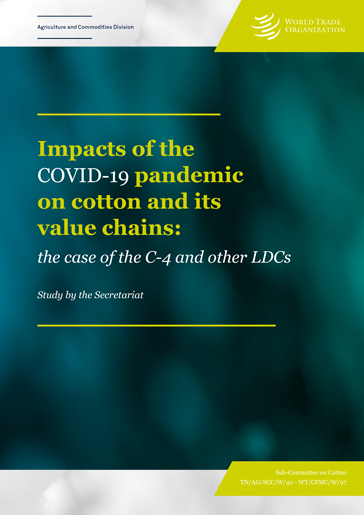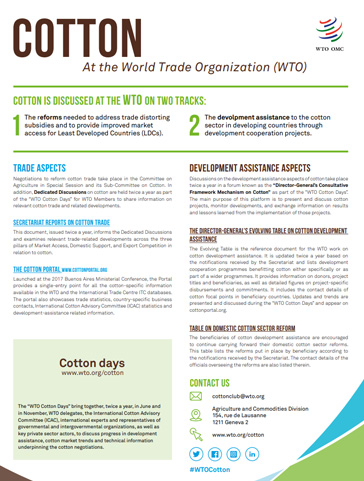AGRICULTURE AND DEVELOPMENT: COTTON
Cotton
Cotton is discussed at the WTO under two complementary tracks: 1) trade aspects, around the multilateral negotiations to address distorting subsidies and trade barriers for cotton; and 2) development assistance provided to cotton production and its value chain. These two tracks reflect the clear linkages and possible synergies between cotton trade and development assistance in a number of developing and least-developed countries (LDCs) Members, impacting millions of people worldwide.
See also:
Sanitary and phytosanitary measures
i.e. food safety and animal-plant health
Standards and Trade Development Facility
Helping developing countries meet food and health standards
News
The trade aspects of cotton are handled by the Committee on Agriculture in Special Session (CoASS) including through dedicated discussions on trade in cotton, chaired by the Chairperson of the CoASS.
The development assistance aspects of cotton are discussed in the meetings of the “Director-General’s Consultative Framework Mechanism on Cotton” (DGCFMC). Deputy Director-General Jean-Marie Paugam currently chairs these discussions on behalf of the Director-General.
These discussions have been developed over the years as a response to a series of proposals to address the sector tabled by four African countries — Benin, Burkina Faso, Chad and Mali, subsequently joined by Cote d'Ivoire — known as the Cotton Four or C4.
Several specific initiatives described below have been carried out in this context to achieve the various objectives agreed by the Membership.
Development assistance aspects of cotton
Discussions on the development aspects of cotton take place bi-annually at the “Director General’s Consultative Framework Mechanism on Cotton - DGCFMC”. The main purpose of these discussions is to track developments and exchange information on development assistance provided to developing countries. This is recorded through the “Evolving Table" on cotton development assistance. These meetings also provide opportunities for presentations and discussions on relevant trade data, cotton production information and other relevant topics applicable to cotton. The International Cotton Advisory Committee (ICAC) regularly participates in the DGCFMC meetings and presents on the latest information on the global cotton situation, including relevant updates on the best cotton farming practices and market trends. Hence, the DGCFMC serves as a unique international forum for interaction amongst multilateral agencies and different stakeholders of the global cotton community.
The 2013 Bali Ministerial Conference and the 2015 Nairobi Decision on Cotton further underscored the importance that Members attach to the development assistance aspects of cotton, as well as infrastructure support programmes or other assistance related to the cotton sector to tackle the priorities identified by LDC cotton producers. These include multidimensional and integrated programmes and projects at the regional and sub-regional level which are submitted to development partners. For this purpose, in 2021 a list of project requests submitted by developing countries seeking international assistance for their cotton sector was introduced in the "Evolving Table".
Cotton partners' conferences
Two Cotton Partners' Conference have been held, at the request of Members, in 2019 and 2022. These events represented unique high-level platforms for development cooperation partners to discuss their engagement for the sustainable development of the cotton sector, particularly in "Cotton 4" (C-4) countries, and in Least-Developed Countries (LDCs).
The latest Cotton Partners' Conference took place on the 27th of July 2022 and was jointly organised by the Secretariats of the WTO, ITC, and UNCTAD to support LDCs' efforts to create new partnerships and leverage resources and technical expertise enabling the implementation of cotton projects at the national, sub-regional and continental levels. The event focused on requests tabled by the C-4 and other cotton producing developing countries who need assistance to build a more resilient cotton sector in the aftermath of the COVID-19 pandemic.
The focus of the Conference was on cotton’s contribution to mitigating climate change, reducing poverty, enhancing food security, and the creation of jobs in value addition, especially for women and youth.
World cotton day
On 7 October 2019, at the request of C-4 countries supported by other WTO Members, the WTO together with the United Nations Food and Agriculture Organization (FAO), the United Nations Conference on Trade and Development (UNCTAD), the International Cotton Advisory Committee (ICAC), and the International Trade Centre (ITC) organized a World Cotton Day launch event at the WTO's headquarter in Geneva, Switzerland. The event was attended by over 800 participants, including Ministers, high-level officials, heads of international organizations, Geneva-based delegates and the global cotton community - national growers associations, traders, inspection services providers, cotton promoters, development assistance partners, scientists, scholars, retailers, brand representatives, and the private sector.
In August 2021, the General Assembly of the United Nations recognized the unique characteristics of cotton by proclaiming 7 October of each year World Cotton Day. The objective of this global celebration is to draw attention to the hundreds of millions of people around the world who earn their livelihoods through the cotton value chain. The WTO is actively involved in annual events to celebrate this important date, aimed to raise the cotton trade profile and achieve further benefits to cotton producers and cotton trade around the globe.
By-products from cotton production and transformation
Seeds, stalks, hulls, and linters, and the products that can be derived from these parts of the cotton plant such as edible oil, cake, and fertilizers, are commonly referred to as cotton by-products. They are used extensively in several cotton-producing countries to obtain, for instance, protein-rich edible oil and phosphorous-rich animal feed.
Cotton producing LDCs have highlighted that there are multiple supply-side and trade constraints that hinder their ability to exploit the full value of cotton by-products. Examples, include poor infrastructure and limited access to the latest technologies, for instance for oil extraction.
In order to overcome these obstacles and create additional revenue streams from the production, processing, and trade of cotton, the C-4 countries has requested the Secretariat of the WTO, UNCTAD, and ITC, to develop a joint initiative on cotton by-products development in LDCs.
Documents: development aspects
Search Documents Online
Documents on the Director-General’s Consultative Framework Mechanism on Cotton use the code WT/CFMC/*
These links open a new window: allow a moment for the results to appear.
> quick help with downloading
> comprehensive help on Documents Online
- All documents (Document code WT/CFMC/*) > search
- Meeting reports (Document code WT/CFMC/* and “Report of the” + “Round of the Director-General’s Consultative Framework Mechanism on Cotton”) > search
- Working documents including information from members (Document code WT/CFMC/W/*) > search
- Director-General’s periodic report (Document code WT/CFMC/DG/*) > search
- Evolving table (Document code WT/CFMC/6/*) > search
- Table on Domestic Cotton Sector Reform (Document code WT/CFMC/21/*) > search
- Documentation references and schedule of meetings (Document code WT/CFMC/W/24/*) > search
You can perform more sophisticated searches from the Documents Online search facility (opens in new window) by defining multiple search criteria such as document symbol (i.e. code number), full text search or document date.
Trade in cotton: negotiations and dedicated discussions
Negotiations to reform trade in cotton take place in the Committee on Agriculture in Special Session. In addition, dedicated discussions on cotton are held twice a year for WTO members to share information on cotton trade.
Outcome of negotiations
Under the December 2015 Nairobi Ministerial Decision on Cotton, developed countries and developing countries in a position to do so have committed to grant, to the extent provided for in their respective preferential trade arrangements, duty-free and quota-free market access for exports of cotton and cotton-related agricultural products from least-developed countries (LDCs). Ministers also agreed that the decision to abolish agricultural export subsidies, as contained in the Nairobi Decision on Export Competition, would be implemented with regard to cotton immediately by developed countries and not later than 1 January 2017 by developing countries. The Nairobi decision also acknowledges the efforts made by some WTO members to reform their domestic cotton policies but emphasizes that more efforts are needed. The negotiations on cotton have been continuing as part of the overall agriculture negotiations.
Dedicated discussions on cotton
Dedicated discussions are an outcome of the December 2013 Bali Ministerial Conference subsequently reconfirmed by the December 2015 Nairobi Ministerial Decision on Cotton, where ministers agreed “to enhance transparency and monitoring in relation to the trade-related aspects of cotton”. These discussions are held twice a year, in the context of the Committee on Agriculture in Special Session, back-to-back with the DGCFMC as part of a WTO "cotton days".
Dedicated Discussions rely on factual information compiled by the WTO Secretariat from notifications and other information provided by WTO members, as well as other sources such as presentations by ICAC on cotton markets trends. The discussions are aimed at informing the negotiations on this topic.
Documents: Trade negotiations and dedicated discussions on cotton
Search Documents Online
Documents on the Cotton Sub-committee use the code TN/AG/SCC/*.
These links open a new window: allow a moment for the results to appear.
> quick help with downloading
> comprehensive help on Documents Online
- All documents (Document code TN/AG/SCC/*) > search
- Meeting reports (Document code TN/AG/* or TN/AG/SCC/* and [“report by the chairman” or “report by the chairperson” or “report by the chair”]) > search
- Secretariat reports on cotton trade (Document code TN/AG/GEN/34 and TN/AG/GEN/34/* or TN/AG/SCC/GEN/13 and TN/AG/SCC/GEN/13/*) > search
- Members’ submissions (included among documents with code TN/AG/GEN/* and or TN/AG/SCC/GEN/*) > search
You can perform more sophisticated searches from the Documents Online search facility (opens in new window) by defining multiple search criteria such as document symbol (i.e. code number), full text search or document date.
Background
Cotton has been discussed at the WTO since the Cotton Four’s 2003 Sectoral Initiative on Cotton, and the 1 August 2004 General Council decision — sometimes called the “July 2004 Package” — covering all subjects in the WTO negotiations. The decision says that cotton will be addressed “ambitiously, expeditiously and specifically” within the agriculture negotiations.
As a result, a Cotton Sub-Committee was set up under the auspices of the Committee on Agriculture in Special Session on 19 November 2004 to hold specific discussions on cotton in the context of the negotiations. Nowadays, discussions on cotton in the agricultural negotiations mostly take place in meetings of the Committee on Agriculture in Special Session.
The December 2005 Hong Kong Ministerial Declaration said that “all forms of export subsidies for cotton will be eliminated by developed countries in 2006”; “developed countries will give duty and quota free access for cotton exports from least-developed countries (LDCs) from the commencement of the implementation period”; and as a priority, that as an outcome of the negotiations “trade distorting domestic subsidies for cotton production be reduced more ambitiously” and more quickly “than under whatever general formula is agreed”.
Cotton has been an important topic in the agriculture negotiations to remove trade barriers and curb subsidies. The draft texts circulated by the chairperson of the agriculture talks between 2006 and 2008 contained specific provisions on cotton.
In the concluding statement of the December 2011 Ministerial Conference, ministers confirmed their commitment to on-going dialogue and engagement to address cotton “ambitiously, expeditiously and specifically”, within the agriculture negotiations.
The December 2013 Bali Ministerial Decision on cotton reaffirmed previous commitments, particularly from the 2004 General Council decision, the 2005 Hong Kong Ministerial Declaration and the commitment of the 2011 Geneva WTO Ministerial Conference. It undertook to enhance transparency and monitoring in relation to the trade-related aspects of cotton, through bi-annual dedicated discussions (see above).
The 2015 Nairobi Ministerial Decision on Cotton contains provisions on improving market access for least-developed countries, reforming domestic support and eliminating export subsidies. Both Bali and Nairobi Decisions underline the importance of effective assistance to support the cotton sector in developing countries (see above).
Find out more
Introduction to the cotton initiative.
Documents
Impacts of the COVID-19 pandemic on cotton and its value chains:the case of the C-4 and other LDCs



- Cotton Portal - Trade Intelligence for Cotton
Includes meetings of dedicated discussions on Cotton
Problems viewing this page? If so, please contact [email protected] giving details of the operating system and web browser you are using.

